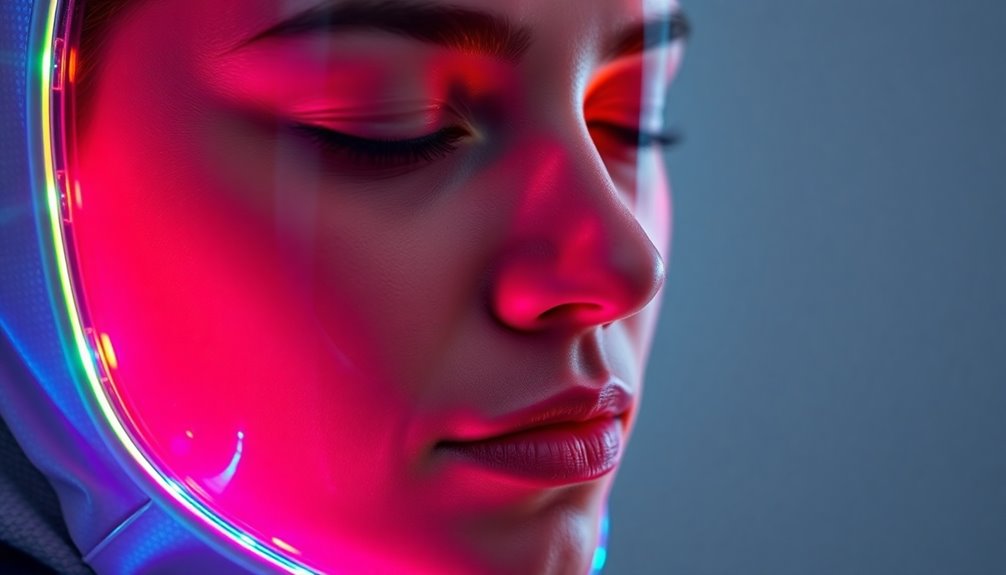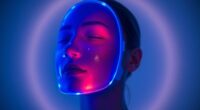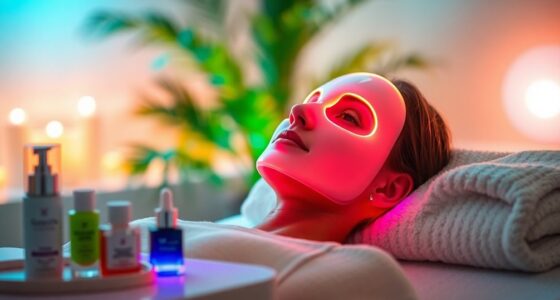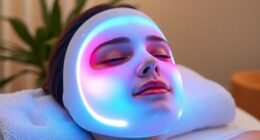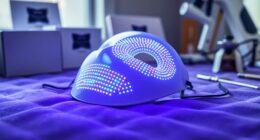LED masks work by using specific light wavelengths to target various skin issues. Red light stimulates collagen production, reducing wrinkles and improving skin elasticity, while blue light helps clear acne-causing bacteria and controls oil. Near-infrared light supports wound healing and reduces inflammation. The result is healthier, more youthful skin with regular use. To better understand how they can benefit your skin type specifically, you can explore their unique mechanisms and various features.
Key Takeaways
- LED masks emit specific light wavelengths that penetrate the skin, triggering cellular activity for healing and rejuvenation.
- Red light stimulates collagen production, reducing wrinkles and enhancing skin elasticity for a youthful appearance.
- Blue light targets acne-causing bacteria, helping to prevent breakouts and regulate oil production for clearer skin.
- Near-infrared light promotes wound healing and reduces chronic inflammation, improving overall skin health.
- Consistent use of LED masks leads to cumulative benefits, improving skin texture and firmness over time.
What Are LED Masks?
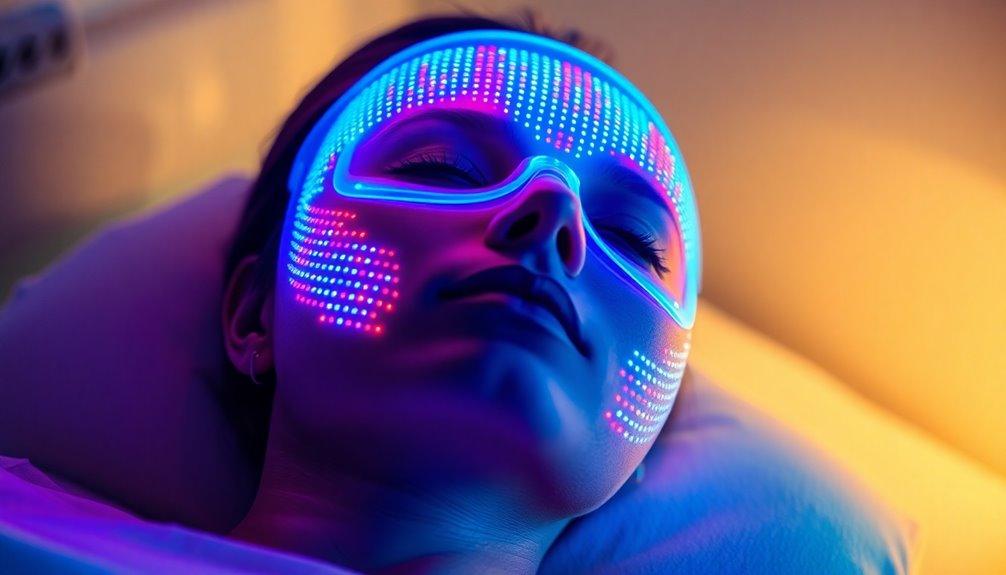
If you’re looking for a non-invasive way to enhance your skincare routine, LED masks might be just what you need. These innovative devices use light-emitting diodes (LEDs) to target various skin concerns.
They typically feature red light and blue light therapy; red light helps boost collagen production and reduces inflammation, while blue light effectively targets acne-causing bacteria. The wavelengths emitted range from 405 to 660 nanometers, ensuring deep penetration into your skin layers.
Many LED masks are designed for home use, making it easy to incorporate light therapy into your daily regimen. With regular sessions of 5 to 20 minutes, you can enjoy cumulative benefits like improved texture, reduced fine lines, and an overall enhanced appearance over time.
How Do LED Masks Function?
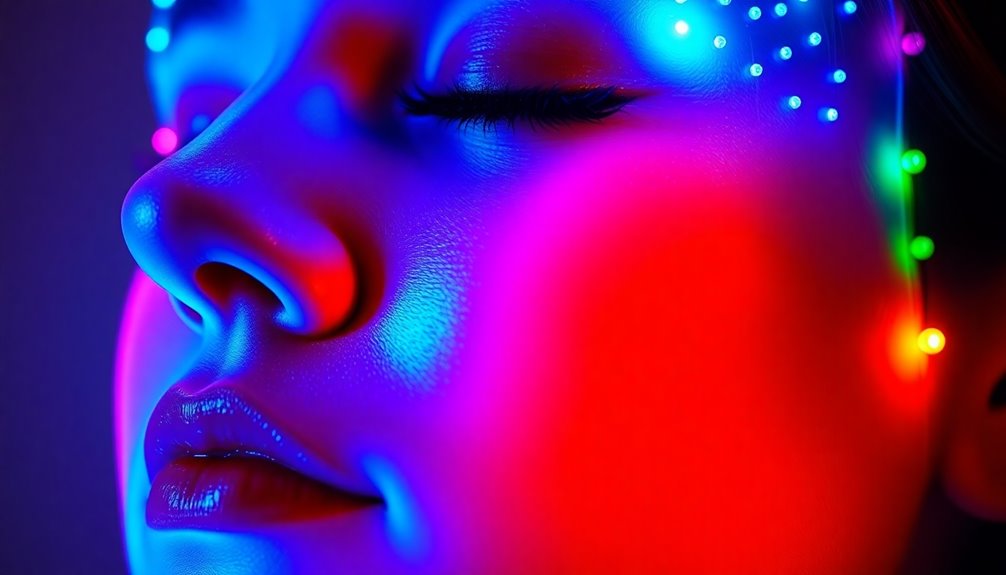
LED masks function by using specific light wavelengths that penetrate your skin, triggering cellular activity.
Different types of light, like red and blue, offer unique benefits, from promoting collagen production to targeting acne.
Understanding how these mechanisms work can help you make the most of your skincare routine.
Mechanism of Action
While you might be curious about how LED masks function, their effectiveness lies in the specific wavelengths of light they emit.
These light-emitting diodes deliver targeted red light therapy, which stimulates collagen production, enhances skin elasticity, and improves overall texture. When you use LED masks, the red light penetrates your skin, promoting increased blood circulation and accelerating skin healing. This process helps reduce wrinkles and fine lines, giving you a youthful glow.
If you’re dealing with acne, LED masks can also include blue light therapy that targets acne-causing bacteria, regulating oil production and providing anti-inflammatory effects.
For best results, remember that regular use for 5 to 20 minutes per session is essential to experience cumulative benefits.
Types of Light
When it comes to LED masks, understanding the types of light they emit is essential for selecting the right treatment for your skin concerns.
Here’s a quick overview of the main types of light:
- Red Light (630-660 nm): Stimulates collagen production and helps reduce wrinkles.
- Blue Light (405-420 nm): Targets acne-causing bacteria and regulates oil production.
- Near-Infrared Light (800-1,400 nm): Penetrates deeper layers of skin, promoting wound healing and reducing chronic inflammation.
- Combination Use: Mixing red and near-infrared lights enhances skin elasticity and firmness for a more youthful appearance.
Consistent use is key, as cumulative effects build over time, so stick to sessions lasting between 5 to 20 minutes for the best results!
Types of Light Emitted by LED Masks
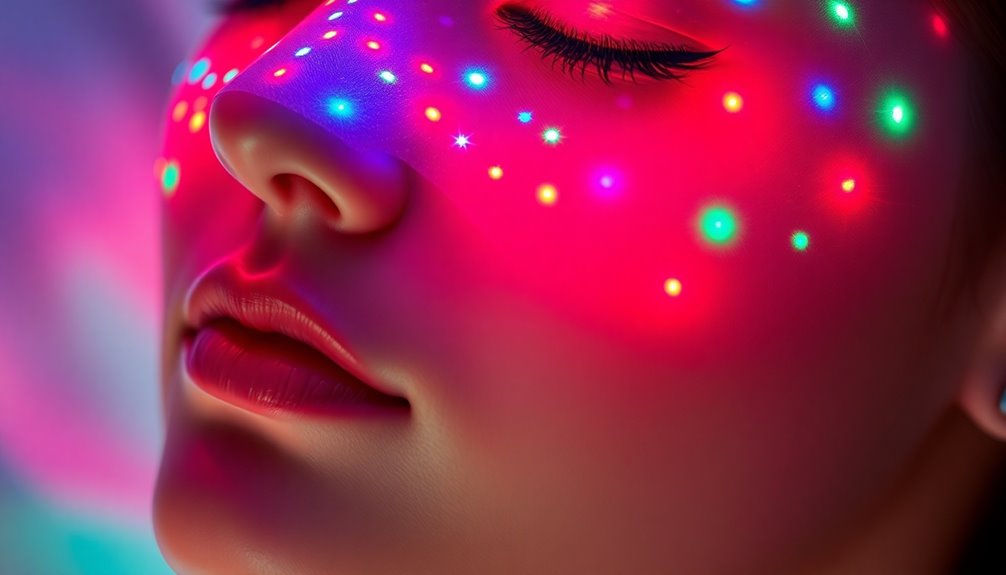
Understanding the types of light emitted by LED masks is essential for choosing the right treatment for your skin concerns. Here’s a quick overview of the primary light types:
| Light Color | Purpose | Wavelength Range |
|---|---|---|
| Red Light Therapy | Stimulates collagen production, anti-aging | 630-660 nm |
| Blue Light Therapy | Kills acne-causing bacteria, prevents breakouts | 405-420 nm |
| Near-Infrared Light | Promotes faster wound healing, reduces inflammation | 800-1,400 nm |
LED Face Masks can combine these light types for versatile treatments tailored to your needs. By understanding each light’s purpose, you can effectively address your skin concerns—whether that’s enhancing collagen production or combating acne. Additionally, the incorporation of different wavelengths allows for targeted therapy, maximizing the LED facial mask effectiveness in treating a variety of skin issues. Users can choose specific settings based on their unique skin concerns, achieving results that align with personal skincare goals. Regular use of these masks can lead to improved skin texture, a more radiant complexion, and a reduction in visible signs of aging.
Benefits of Using LED Masks
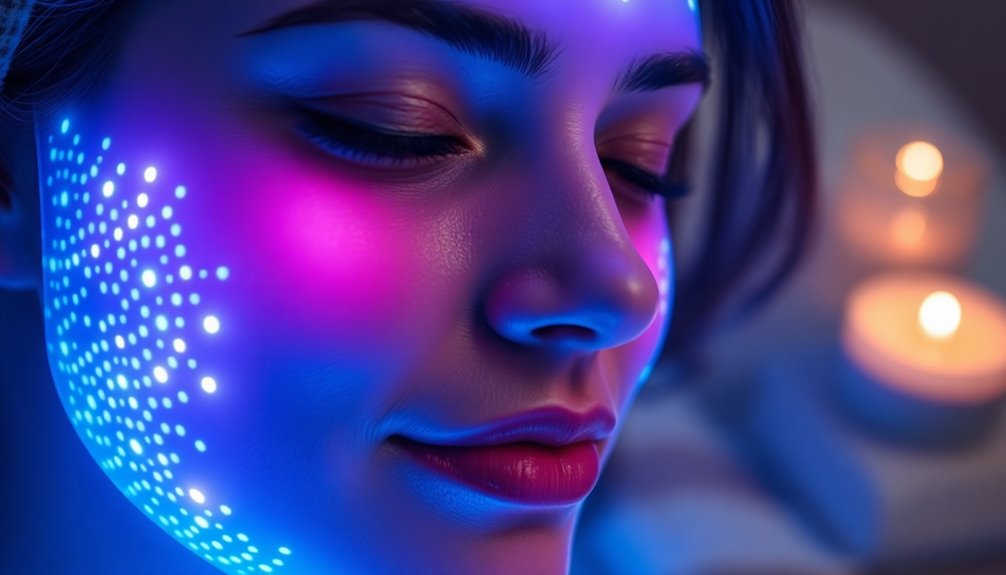
LED masks offer a range of benefits that can transform your skincare routine. Here’s what you can expect:
- Boost collagen production – Regular use stimulates your skin, helping it look plumper and more youthful.
- Reduce inflammation – These masks calm irritated skin, making them great for sensitive complexions.
- Minimize fine lines – Red light therapy enhances blood flow and tissue oxygenation, reducing the appearance of wrinkles.
- FDA cleared – Many LED masks meet safety standards, giving you confidence in their effectiveness for non-invasive skin treatment.
With consistent use of LED masks, you can achieve improved skin texture, firmness, and an overall radiant complexion.
Don’t miss out on these powerful skincare tools!
Mechanism of Action on Skin Cells
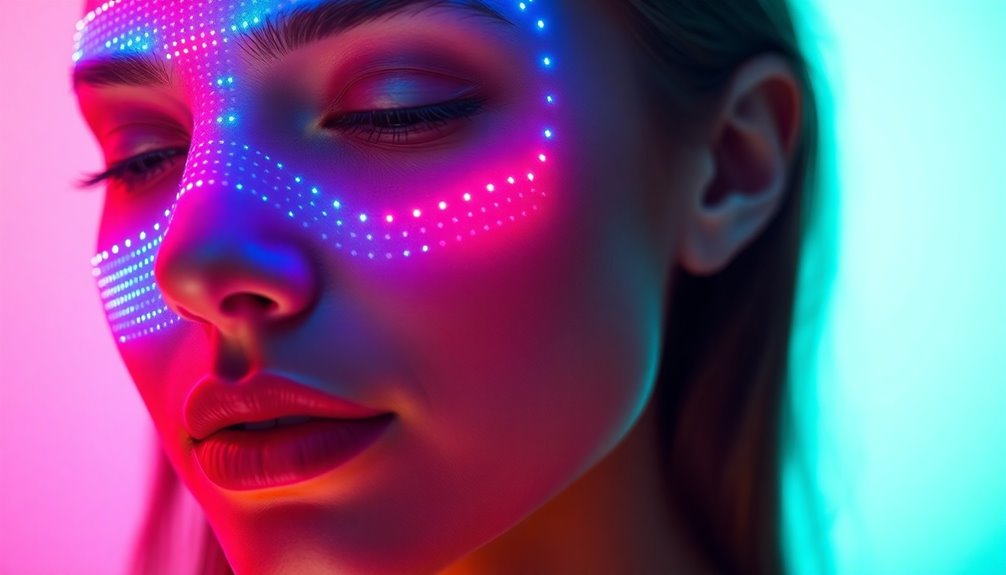
When you use an LED mask, the light penetrates your skin at specific depths, triggering cellular response mechanisms.
This stimulation boosts collagen production, enhancing your skin’s elasticity and reducing signs of aging.
Understanding how these processes work can help you maximize the benefits of your LED therapy.
Light Penetration Depth
As you explore the benefits of LED masks, it’s essential to recognize how different light wavelengths penetrate the skin at varying depths, directly influencing their effectiveness.
Here’s a breakdown of how each type works:
- Red light (630-660 nm): Reaches the dermis, stimulating collagen production and reducing wrinkles.
- Near-infrared light (800-1,400 nm): Investigates deeper, promoting wound healing and reducing chronic inflammation.
- Blue light therapy (405-420 nm): Targets the upper layers, effectively combating acne-causing bacteria and regulating oil production.
- Light penetration depth: Each wavelength’s unique depth allows for targeted treatment of specific skin issues, enhancing overall skin health and appearance.
Understanding these depths helps you choose the right treatment for your skin goals.
Cellular Response Mechanisms
While exploring the benefits of LED masks, you’ll find that their effectiveness hinges on how specific wavelengths of light trigger cellular responses in your skin.
LED masks emit targeted wavelengths of light that penetrate the skin, stimulating cellular activity. For instance, red light therapy, with wavelengths between 630 to 660 nanometers, enhances collagen production by activating fibroblast cells, which play an essential role in skin health.
On the other hand, blue light therapy, around 405 to 420 nanometers, effectively targets acne-causing bacteria, reducing their viability.
Near-infrared light, ranging from 800 to 1,400 nanometers, penetrates deeper, promoting wound healing and reducing chronic inflammation.
Over time, these stimulated cells enhance skin texture and elasticity, showcasing the remarkable potential of LED technology.
Collagen Production Stimulation
LED masks effectively stimulate collagen production in your skin cells through the application of specific wavelengths of light. Utilizing red light therapy, these masks emit light that penetrates the dermis, enhancing cellular activity.
Here’s how it works:
- Wavelengths: Red light ranges from 630 to 660 nanometers, while near-infrared light penetrates deeper (800 to 1,400 nanometers).
- Fibroblast Stimulation: This light stimulates fibroblast activity, essential for skin rejuvenation.
- Collagen Synthesis: Increased fibroblast activity promotes collagen and elastin production.
- Cumulative Effects: Regular use leads to improved skin texture, reduced wrinkles, and a more youthful appearance. Additionally, color accuracy in LED masks can enhance the effectiveness of light therapy by ensuring the right wavelengths are delivered to the skin.
Recommended Usage for Optimal Results
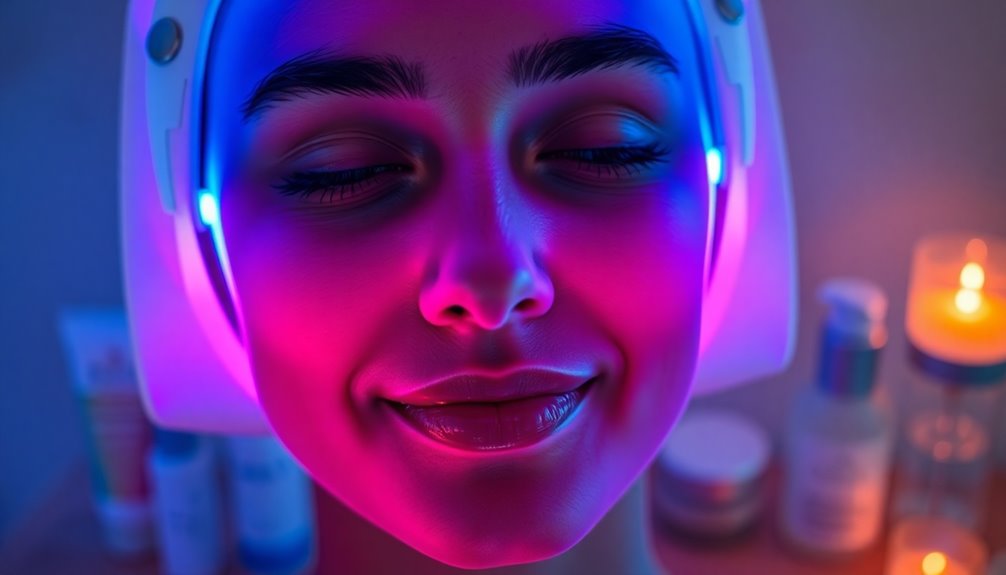
To achieve the best results with your LED face mask, consistency is key. For ideal results, aim to use the mask daily for 5 to 20 minutes over at least a month.
Start by washing and drying your face to guarantee maximum light penetration. Pay attention to the recommended usage and follow the device-specific session times, which typically range from 3 to 10 minutes per treatment, to prevent irritation.
After your session, apply skincare products focusing on hydration, as your skin will absorb them better thanks to the LED therapy.
Finally, consider documenting your progress with photos; this can help you track changes and improvements in your skin’s condition over time.
Safety Considerations for LED Mask Use
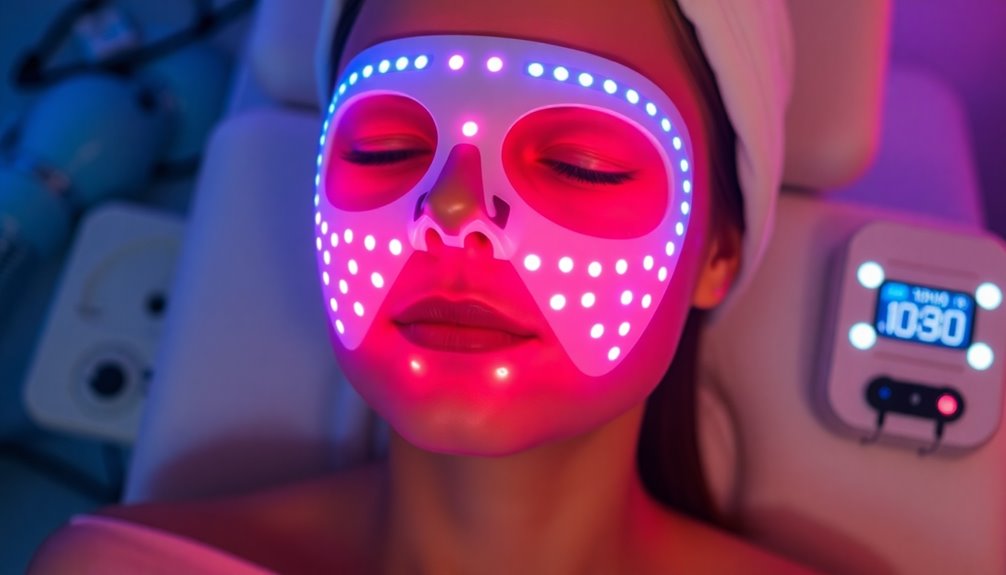
Using an LED mask can greatly improve your skin, but it’s important to keep safety in mind. Here are some safety considerations to follow:
- Consult a Dermatologist: If you have light sensitivity or skin concerns, check with a dermatologist before use.
- Wear Eye Protection: Protect your eyes, especially when using blue light, to prevent potential damage.
- Follow Instructions: Always read and adhere to the manufacturer’s guidelines to avoid misuse and side effects.
- Patch Test: Test the mask on a small skin area first to check for any adverse reactions.
Differences Between Professional and At-Home Devices

While both professional and at-home LED devices aim to enhance your skin, they differ markedly in intensity and effectiveness. Professional treatments typically use higher intensity lights and multiple wavelengths for quicker, noticeable results. In contrast, at-home LED masks may have lower power output and fewer light sources, leading to more subtle improvements over time.
| Feature | Professional Treatments |
|---|---|
| Intensity | Higher, FDA approved |
| Treatment Duration | Longer sessions |
| Results | Immediate improvements |
| Feature | At-Home LED Devices |
| Intensity | Lower power |
| Treatment Duration | Shorter sessions |
| Results | Cumulative, gradual effects |
Regular use of at-home devices is essential to see results comparable to professional treatments.
Common Skin Concerns Addressed by LED Masks
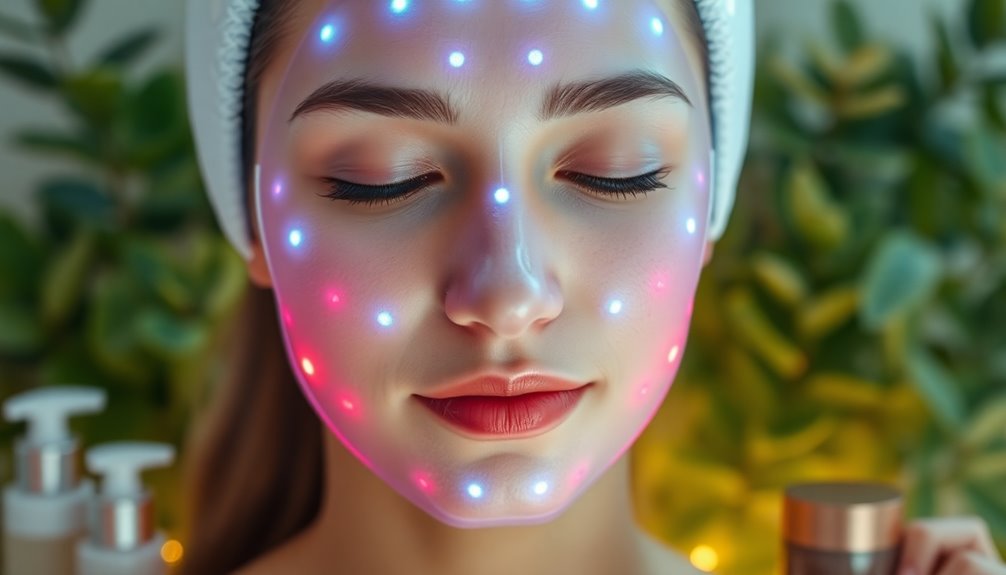
LED masks are becoming a popular solution for addressing a variety of common skin concerns, thanks to their targeted light therapies.
Here’s how they can help you:
- Fine Lines and Wrinkles: Red light therapy boosts collagen and elastin production, improving skin elasticity and texture.
- Acne: Blue light therapy effectively targets acne-causing bacteria, helping to regulate oil production and clear breakouts.
- Wound Healing: Near-infrared light penetrates deeper layers, promoting wound healing and reducing inflammation for various skin conditions.
- Skin Tone and Texture: Regular use can enhance overall skin appearance, leading to reduced redness and improved texture. Additionally, incorporating aromatherapy techniques can further promote relaxation and emotional well-being during your skincare routine.
Incorporating LED light into your skin care routine can tackle these concerns effectively, giving you healthier, more radiant skin.
User Experience and Testimonials

Many users have shared their experiences with LED masks, revealing noticeable improvements in skin texture and a reduction in fine lines after consistent use.
Many appreciate the relaxing user experience, often multitasking by watching TV during treatment sessions. Users report subtle improvements in their skin, with some experiencing significant decreases in acne breakouts due to regular blue light therapy, especially beneficial for acne-prone skin.
The comfortable and adjustable fit of various LED masks allows you to personalize your treatment, enhancing the overall experience.
Consistency is key; most users emphasize the importance of maintaining a consistent routine, typically five times a week, to achieve ideal results.
With dedication, you can enjoy the transformative benefits these innovative devices offer.
Frequently Asked Questions
Does LED Face Mask Therapy Actually Work?
Yes, LED face mask therapy can be effective for many people.
By using specific wavelengths of light, these masks stimulate your skin’s cellular activity, helping reduce wrinkles and improve texture.
You might notice subtle changes after consistent use over a month, especially if you target specific issues like acne or collagen production.
While at-home devices aren’t as strong as professional treatments, regular sessions of 5-20 minutes can still provide noticeable benefits for your skin.
How Often Should You Use a LED Face Mask?
Did you know that regular use of LED face masks can lead to visible improvements in just 4 to 8 weeks?
For ideal results, you should use your LED mask 3 to 5 times a week, with each session lasting 10 to 20 minutes.
Sticking to this routine helps build cumulative effects, enhancing your skin’s texture and tone.
Always follow the manufacturer’s guidelines to avoid irritation and maximize your skincare benefits!
What Are the Disadvantages of a LED Mask?
When considering a LED mask, you should weigh the disadvantages. Excessive use can irritate your skin, especially if you don’t protect your eyes.
You might notice that at-home devices offer only subtle improvements compared to professional treatments. If you have sensitive skin, you could experience increased inflammation or discomfort.
Plus, achieving visible results requires consistent use, which mightn’t fit your schedule or budget. Always prioritize your skin’s health and listen to its needs.
How Do You Get the Best Results From a LED Face Mask?
To get the best results from your LED face mask, use it consistently, aiming for five times a week for 20 minutes each session.
Prep your skin by washing and drying your face beforehand, as this boosts light penetration.
After treatment, apply hydrating skincare products to enhance nutrient absorption.
Also, avoid retinoids or irritating products during this time to prevent irritation.
Finally, take progress photos to track your skin’s improvement over the month.
Conclusion
In the world of skincare, “an ounce of prevention is worth a pound of cure.” LED masks offer a powerful way to enhance your skincare routine, tackling various concerns from acne to aging. By harnessing the benefits of light therapy, these devices can rejuvenate your skin and boost your confidence. Whether you choose a professional treatment or an at-home device, incorporating LED masks into your regimen might just be the glow-up you’ve been looking for!
